Samsung Galaxy Note 3 Review
by Brian Klug on October 1, 2013 9:00 AM EST- Posted in
- Smartphones
- Samsung
- Mobile
- Android 4.3
- galaxy note 3
Display
One of my only issues with the Note 2 after using it for a long time was resolution. Although the move to a subpixel matrix with a full 3 subpixels per pixel on the Note 2 honestly really put most of my concerns at bay at launch, 720p started to feel limiting further on in that product’s cycle. Having more display area is great, however in Android what really matters is resolution. It was ironic having this phone with a huge display, but 720p resolution that was quickly eclipsed by devices with so much smaller displays. With the Note 3 Samsung moves to 1080p at 5.7 inches, up from the 720p at 5.5 inches in the Note 2, and 1280x800 at 5.3 inches from the original Note.
A question that immediately comes up every time we get a Samsung phone with AMOLED is first, what kind, and second what subpixel unit cell is behind it all, be it an RGB stripe or some other RG,BG alternative unit cell. In the case of the Note 3 we unsurprisingly see Samsung use the same unit cell as they did on SGS4, an offset pattern with green on one line and red and blue on another line. There’s a square blue subpixel with more area than the circular red and green subpixels as well to compensate for the difference in luminous efficiency of the material used in each subpixel type. As I’ve said in the past this isn’t PenTile (although people have started using that brand as a proxy for RG,BG alternatives) but something else entirely, but the ultimate end is still the same, two subpixels per unit pixel and not an RGB stripe.
The question for most normals then becomes – is this a big deal or can a normal human being see it? I’d argue that the subpixels on the Note 3, like the SGS4, are now small enough that they can’t be seen. I used to very picky about this, but I don’t find the new offset RG,BG pattern distracting at all on the Note 3. Subpixel size moves from just above 1 arcminute (1.006 and 1.073 for the Note and Note 2 respectively) down to 0.741 for the Note 3, making them small enough to in theory exceed human eye resolution of 1 arcminute. I won’t break out the huge table or chart, or go over all of that again, but it’s nice to see that finally be the case with the Note 3.
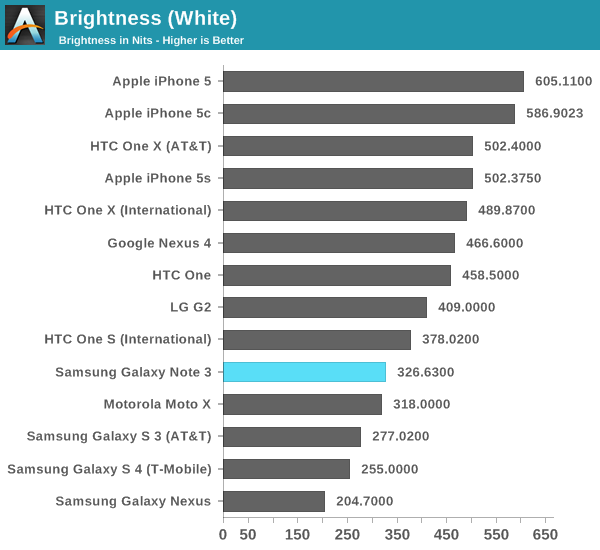
The Note 3 has the same display mode settings as we’ve seen in other generations, these mDNIe toggles allow some control over display color curves. They’re ultimately not a mitigation for Android’s lack of a real CMS and don’t completely solve the oversaturation issue that comes hand in hand with AMOLED’s different spectral curves, but they do help somewhat. These are unchanged as well from the SGS4 – Adapt Display is checked by default and will select which mode to use automatically for first party apps and a few others, but you can select between dynamic, standard, professional photo, and movie manually, which have different tunings for white point, gamut, and saturation. There’s also still the toggle for automatically adjusting screen tone depending on what’s being displayed.
Of the modes and configuration options available, I don’t doubt for a second that the most used one will be the defaults, however if you’re looking for the most sane from a color accuracy perspective it’s still Movie mode with the auto screen tone toggle unchecked. I gave Samsung the benefit of the doubt and ran all my measures in Movie mode as a result, but also took saturation measures of the other modes so you can see the difference in gamut and saturation with what you get under those.

The Standard and Dynamic modes have a ton of oversaturation, extending far beyond sRGB. In Dynamic mode we can also see some compression going on at the higher saturation levels, effectively blowing out those colors even more, with the second to last point almost on top of the last point. Pro Photo mode clamps down gamut and makes saturation a bit more linear, but has some odd other artifacts that show up. With the Movie selection made, the Note 3 display is considerably more controlled and linear, and makes a dramatic difference in how everything appears on the Note 3 during normal use. If you care about display really this is the only setting you should be using.
White point in movie mode is still bluer than I’d like at an average of just over 7100K, but in the all important Gretag Macbeth patch test, Delta-E is pretty low and puts it among iPhone 5, HTC One, and G2 territory. The results under movie mode from the Note 3 are actually nicely controlled. It still isn’t perfect, but there’s at least been an attempt made to give users that option if they don’t want garish colors that might look great on a store display but not so great if you care about matching photos you’ve taken to a display or print later, or web content between desktop and mobile.
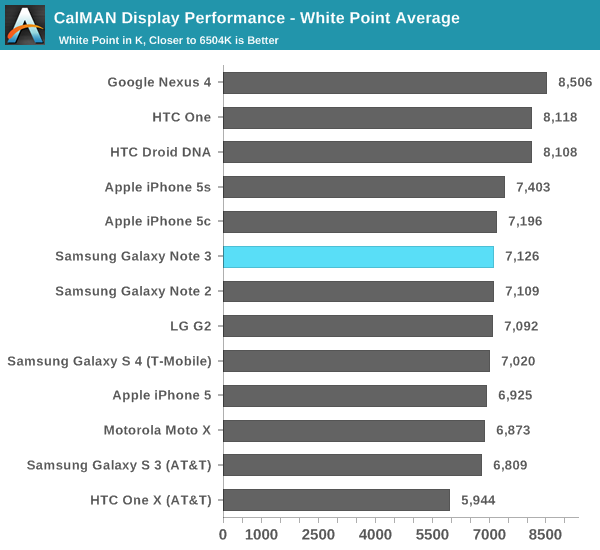
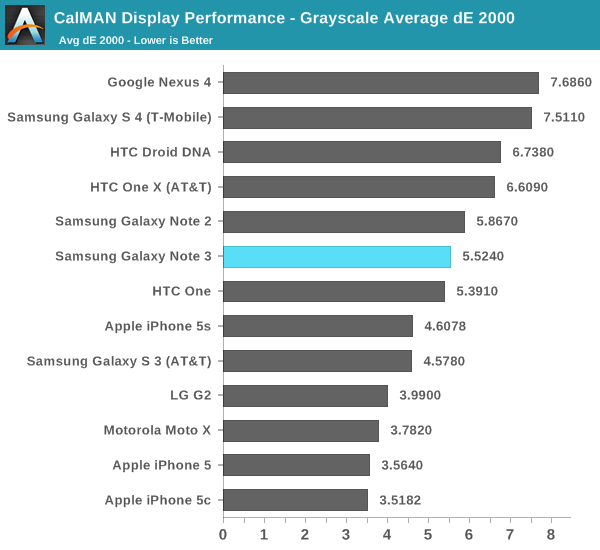
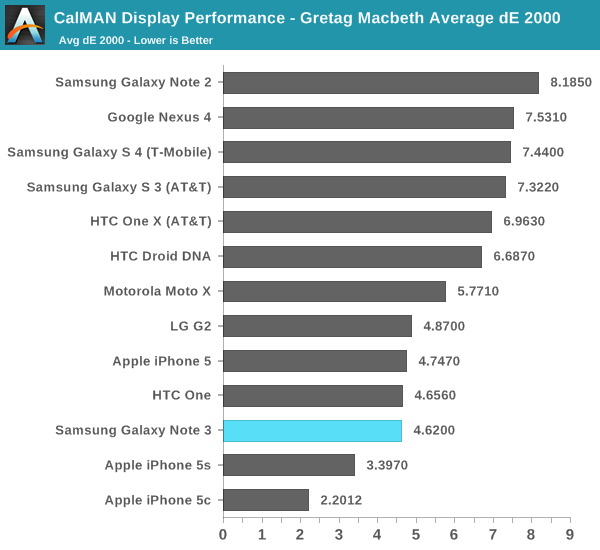
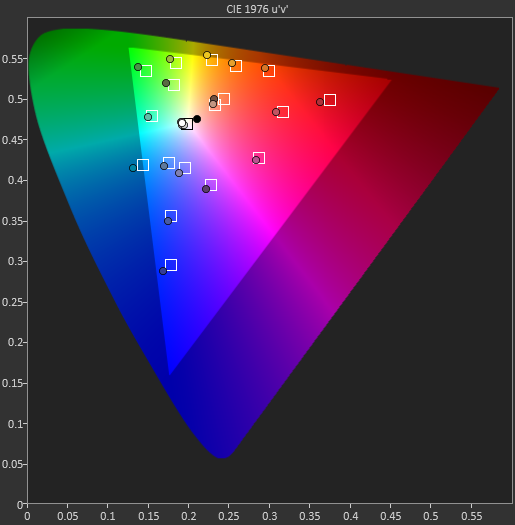
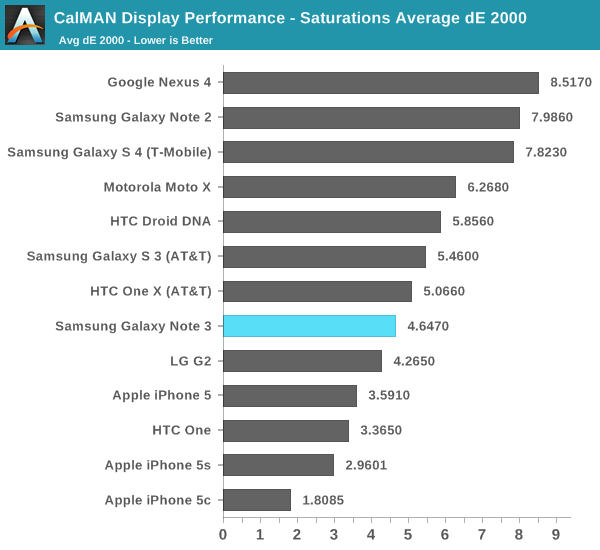



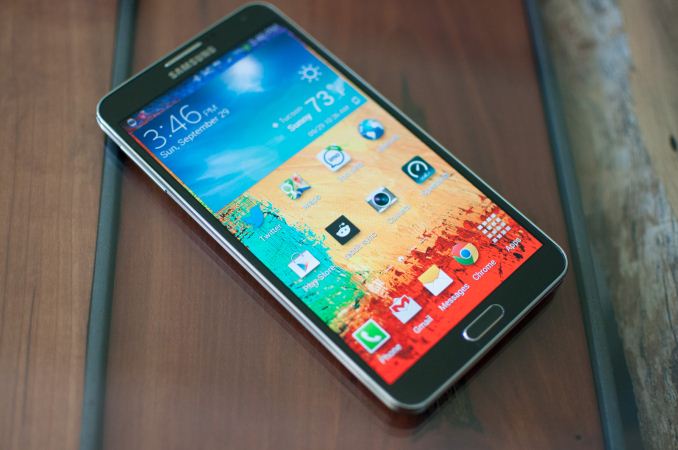
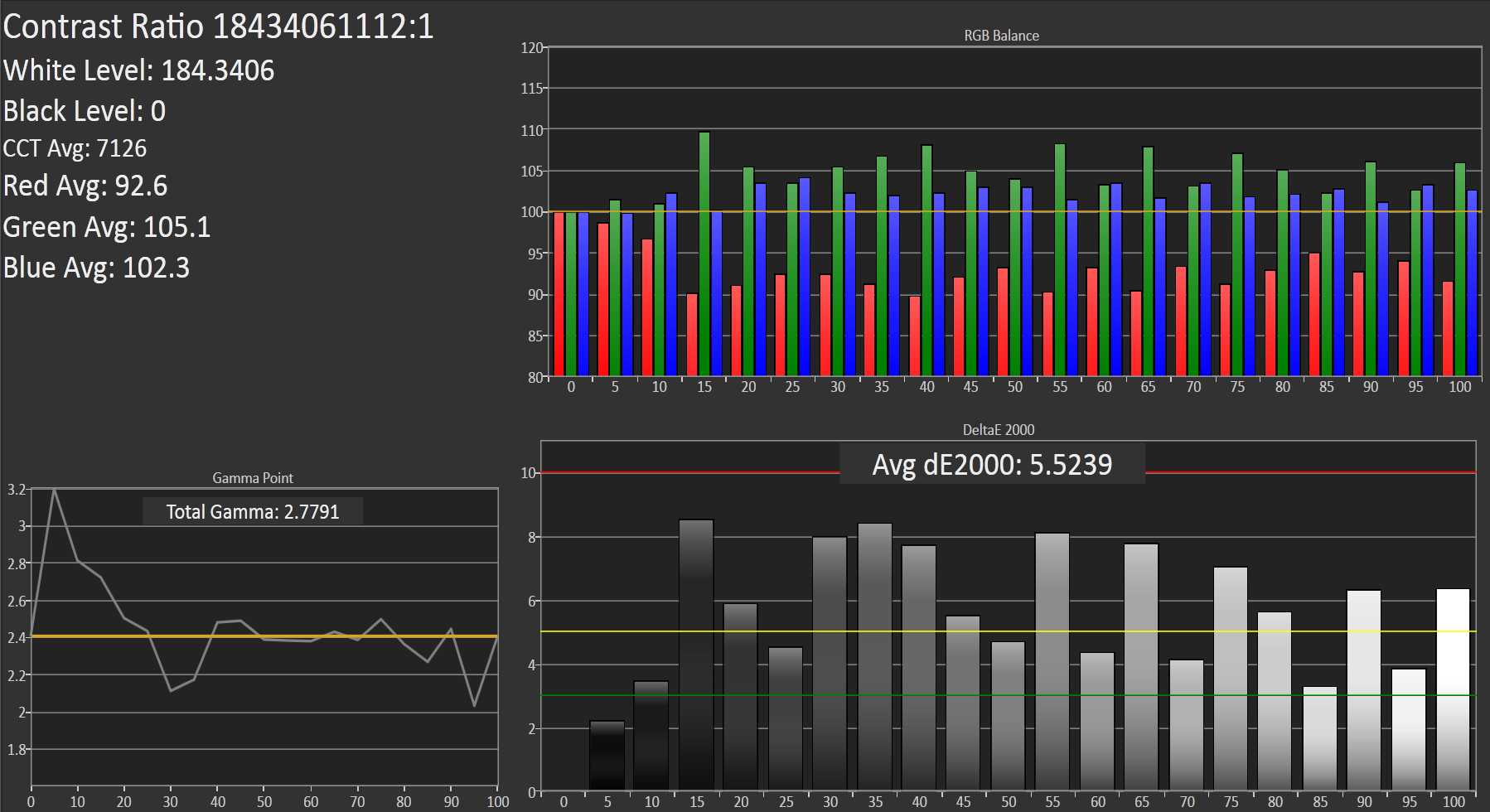








302 Comments
View All Comments
Scipio Africanus - Tuesday, October 1, 2013 - link
Got to hand it to Apple's newest SoC for its phenomenal single core performance. It looks to be ahead of everyone. Non-ARM designed CPUs will be the way forward for phones here. While A15 is nice, it's power envelope is just not that great for phones. So we have Qualcomm and Apple and Samsung only using ARM designed cores. So for Android's sake, hopefully Project Denver will actually pan out so we have some more competition in this space.And I have to get this off my chest but I love my Note 2, its nearly perfect. EXCEPT for the GPU. It was at best low to midrange when it came out and now its just low end. They put in what was a really fast CPU at the time and not so great GPU.
ddriver - Tuesday, October 1, 2013 - link
It is no more than ~20% (at best, limited case scenarios) better with native code, the BS JS benchmarks should be disregarded because they use completely different engine implementations, plus everybody cheats at those like there is no tomorrow. And if for some reason you really need CPU performance on a mobile, the note 3 will actually trounce the 5s considering it has twice the cores and number-crunching tasks scale pretty much perfectly. Considering the snapdragon 800 has the same NEON width as A7, I expect the note 3 to be a good 50% better at number crunching - software rendering, audio/video editing, multiphysics and whatnot.While some might look at the snapdragon 800 for being "inferior" since it is based on arm v7, it is not like the note 4 will come with a quad core v8 chip at 2.3 Ghz, even with a v8 chip it will only be incrementally faster. No consumer device manufacturer will shoot himself in the foot by releasing something better than the bareincremental minimum needed.
That is the reason I'll be getting the note 3, here it is 25% cheaper, has a pressure sensitive stylus, huge screen, 4k video, usb 3, better GPU and all the bells and whistles of latest contemporary tech... The 5s better single thread performance is nowhere nearly enough to make up for all the advantages of the note 3.
Scipio Africanus - Tuesday, October 1, 2013 - link
I never said the 5S was superior in any way except for its single threaded performance. The Note 2 that I own today is a phenomenal device and the only thing I'd replace it with is another phablet type such as a Note 3 (or 4) or maybe an Optimus G Pro or Xperia Z. I still love having an SD card and removable battery so it looks like the Note series is it for me.The 64-bit move is just getting ready for the future IMHO in terms of memory addressing. Using that particular stat as a "feature" is just marketing. The larger number of registers in ARM V8 is nice and does help the Iphone in 64-bit application benchmarks. But most people don't have a clue what 64-bit means except that its bigger than 32.
KPOM - Wednesday, October 2, 2013 - link
The point is that Apple optimized the hardware and software for its intended purpose. No one is running a Monte Carlo analysis on a smartphone. Mobile software isn't really optimized for quad-core processors, and heat concerns limit their usefulness right now. For the purpose of running mobile software, a well-optimized dual-core processor running at a lower clock speed appears to be better than a less optimized quad-core running at a higher clock speed. It's like the Pentium 4 vs. the Pentium M and Core2 architectures. The latter two were superior even though they ran at lower clock speeds.steven75 - Wednesday, October 2, 2013 - link
Why do you trumpet things like "USB 3" when this very review shows it offers no benefits? Does reading out spec lists impress your friends or something?PxNZone - Wednesday, October 2, 2013 - link
Maybe you should check that section again about USB 3. There is an updated part. It states that the connection transfer speed is faster with Windows PC that has USB 3.0.Wolfpup - Tuesday, October 1, 2013 - link
5.7" Grrr, if Apple isn't going to release a larger phone, I wish they'd turn say the iPad mini INTO a phone. The mini seems to be pocketable, and it's obviously already very close to being a phone as it is...I'm sick of having to drool over awesome sized screens on the Android devices.
ddriver - Tuesday, October 1, 2013 - link
Seriously, all the apple fanboys b1tch about how the note series is "ridiculously, embarrassingly big" and you want to use the ipad mini as a phone :DWell, it makes sense, just like with plastic, plastic was lame and cheap-ass until the iphone 5c, and suddenly plastic became great. The ridiculous review at engadget b1tching about the note 3 plastic while praising the 5c plastic...
darkcrayon - Tuesday, October 1, 2013 - link
You realize not all plastic is the same right? And you can't even see the hole in your own example - Apple released a plastic phone as the lower end model to their metal device (something they've been doing on and off for well over a decade now).ddriver - Tuesday, October 1, 2013 - link
Lower end? It is more expensive than 99% of the phones on the market. And in this particular case, the plastic is exactly the same - POLYCARBONATE. Naturally, in the mind of an apple fanboy, the plastic on the 5c is special and magic and full of awesome...